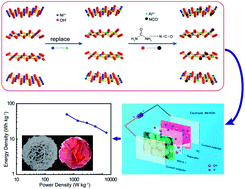Controllable synthesis of aluminum doped peony-like α-Ni(OH)2 with ultrahigh rate capability for asymmetric supercapacitors†
Abstract
Ion substitution and micromorphology control are two efficient strategies to ameliorate the electrochemical performance of supercapacitors electrode materials. Here, Al3+ doped α-Ni(OH)2 with peony-like morphology and porous structure has been successfully synthesized through a facile one-pot hydrothermal process. The Al3+ doped α-Ni(OH)2 electrode shows an ultrahigh specific capacitance of 1750 F g−1 at 1 A g−1, and an outstanding electrochemical stability of 72% after running 2000 cycles. In addition, the Al3+ doped α-Ni(OH)2 electrode demonstrates an excellent rate capability (92% retention at 10 A g−1). Furthermore, by using this unique Al3+ doped α-Ni(OH)2 as the positive electrode and a hierarchical porous carbon (HPC) as the negative electrode, the assembled asymmetric supercapacitor can demonstrate a high energy/power density (49.6 W h kg−1 and 14 kW kg−1). This work proves that synthesizing an Al3+ doped structure is an effective means to improve the electrochemical properties of α-Ni(OH)2. This scheme could be extended to other transition metal hydroxides to enhance their electrochemical performance.



 Please wait while we load your content...
Please wait while we load your content...